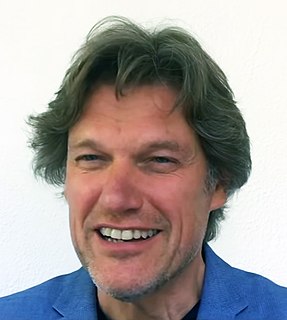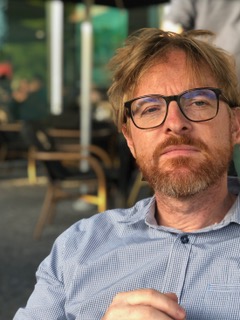
Transcranial magnetic stimulation (TMS) is a noninvasive form of brain stimulation in which a changing magnetic field is used to cause electric current at a specific area of the brain through electromagnetic induction. An electric pulse generator, or stimulator, is connected to a magnetic coil, which in turn is connected to the scalp. The stimulator generates a changing electric current within the coil which induces a magnetic field; this field then causes a second inductance of inverted electric charge within the brain itself.

Functional neuroimaging is the use of neuroimaging technology to measure an aspect of brain function, often with a view to understanding the relationship between activity in certain brain areas and specific mental functions. It is primarily used as a research tool in cognitive neuroscience, cognitive psychology, neuropsychology, and social neuroscience.
The first neuroimaging technique ever is the so-called 'human circulation balance' invented by Angelo Mosso in the 1880s and able to non-invasively measure the redistribution of blood during emotional and intellectual activity. Then, in the early 1900s, a technique called pneumoencephalography was set. This process involved draining the cerebrospinal fluid from around the brain and replacing it with air, altering the relative density of the brain and its surroundings, to cause it to show up better on an x-ray, and it was considered to be incredibly unsafe for patients. A form of magnetic resonance imaging (MRI) and computed tomography (CT) were developed in the 1970s and 1980s. The new MRI and CT technologies were considerably less harmful and are explained in greater detail below. Next came SPECT and PET scans, which allowed scientists to map brain function because, unlike MRI and CT, these scans could create more than just static images of the brain's structure. Learning from MRI, PET and SPECT scanning, scientists were able to develop functional MRI (fMRI) with abilities that opened the door to direct observation of cognitive activities.
Neurotechnology encompasses any method or device in which electronics interface with the nervous system to monitor or modulate neural activity.

Neuroimaging is the use of quantitative (computational) techniques to study the structure and function of the central nervous system, developed as an objective way of scientifically studying the healthy human brain in a non-invasive manner. Increasingly it is also being used for quantitative studies of brain disease and psychiatric illness. Neuroimaging is a highly multidisciplinary research field and is not a medical specialty.
Neuroergonomics is the application of neuroscience to ergonomics. Traditional ergonomic studies rely predominantly on psychological explanations to address human factors issues such as: work performance, operational safety, and workplace-related risks. Neuroergonomics, in contrast, addresses the biological substrates of ergonomic concerns, with an emphasis on the role of the human nervous system.
Neurophysics is the branch of biophysics dealing with the development and use of physical methods to gain information about the nervous system. Neurophysics is an interdisciplinary science using physics and combining it with other neurosciences to better understand neural processes. The methods used include the techniques of experimental biophysics and other physical measurements such as EEG mostly to study electrical, mechanical or fluidic properties, as well as theoretical and computational approaches. The term "neurophysics" is a portmanteau of "neuron" and "physics".
Integrative neuroscience is the study of neuroscience that works to unify functional organization data to better understand complex structures and behaviors. The relationship between structure and function, and how the regions and functions connect to each other. Different parts of the brain carrying out different tasks, interconnecting to come together allowing complex behavior. Integrative neuroscience works to fill gaps in knowledge that can largely be accomplished with data sharing, to create understanding of systems, currently being applied to simulation neuroscience: Computer Modeling of the brain that integrates functional groups together.

Steven Laureys is a Belgian neurologist. He is recognized worldwide as a leading clinician and researcher in the field of neurology of consciousness.
The Athinoula A. Martinos Center for Biomedical Imaging, usually referred to as just the "Martinos Center," is a major hub of biomedical imaging technology development and translational research. Bruce Rosen is the Director of the Center, the Executive Director is David Vaughn, and the Administrative Director is Monica Langone.

Mark S. George is a Distinguished University Professor of psychiatry, radiology and neurosciences and is the director of the Medical University of South Carolina (MUSC) Center for Advanced Imaging Research as well as the Brain Stimulation Laboratory. As of June 2020, his research has been cited over 47,000 times, with an h-index of 113 and i-10 index of 404.

Consciousness after death is a common theme in society and culture in the context of life after death. Scientific research has established that the physiological functioning of the brain, the cessation of which defines brain death, is closely connected to mental states. However, many believe in some form of life after death, which is a feature of many religions.

Resting state fMRI is a method of functional magnetic resonance imaging (fMRI) that is used in brain mapping to evaluate regional interactions that occur in a resting or task-negative state, when an explicit task is not being performed. A number of resting-state brain networks have been identified, one of which is the default mode network. These brain networks are observed through changes in blood flow in the brain which creates what is referred to as a blood-oxygen-level dependent (BOLD) signal that can be measured using fMRI.
Peter T. Fox is a neuroimaging researcher and neurologist at the University of Texas Health Science Center at San Antonio. He is a professor in the Department of Radiology with joint appointments in Radiology, Medicine, and Psychiatry. He is the founding director of the Research Imaging Institute.
Lutz Jäncke is a neuropsychologist and a cognitive neuroscientist.
Kathryn Emma Watkins is an experimental psychologist in the Wellcome Trust centre for integrative neuroimaging at the University of Oxford and a tutorial fellow at St Anne's College, Oxford. Her research investigates the brain processes that underlie speech, language and development.

Functional ultrasound imaging (fUS) is a medical ultrasound imaging technique of detecting or measuring changes in neural activities or metabolism, for example, the loci of brain activity, typically through measuring blood flow or hemodynamic changes. The method can be seen as an extension of Doppler imaging.
Cassandra J. Lowe is a Canadian public health neuroscientist, specializing in understanding why some individuals have a hard time regulating "junk food" consumption. Lowe uses a multidimensional approach that combines repetitive transcranial magnetic stimulation (rTMS), neuroimaging and aerobic exercise to create causal models linking brain health to dietary decisions and behaviours. She is currently a BrainsCAN Postdoctoral Fellow within The Brain and Mind Institute and Department of Psychology at the University of Western Ontario, working with J. Bruce Morton and r. Lindsay Bodell.
Valeria Gazzola is an Italian neuroscientist, associate professor at the Faculty of Social and Behavioral Sciences at the University of Amsterdam (UvA) and member of the Young Academy of Europe. She is also a tenured department head at the Netherlands Institute for Neuroscience (NIN) in Amsterdam, where she leads her own research group and the Social Brain Lab together with neuroscientist Christian Keysers. She is a specialist in the neural basis of empathy and embodied cognition: Her research focusses on how the brain makes individuals sensitive to the actions and emotions of others and how this affects decision-making.

Alexander T. Sack is a German neuroscientist and cognitive psychologist. He is currently appointed as a full professor and chair of applied cognitive neuroscience at the Faculty of Psychology and Neuroscience at Maastricht University. He is also co-founder and board member of the Dutch-Flemish Brain Stimulation Foundation, director of the International Clinical TMS Certification Course, co-director of the Center for Integrative Neuroscience (CIN) and the Scientific Director of the Transcranial Brain Stimulation Policlinic at Maastricht University Medical Centre.